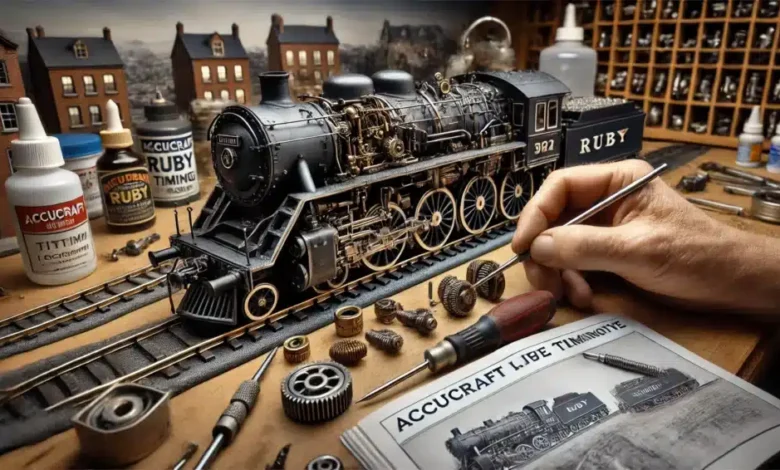How to Set the Timing on an Accucraft Ruby: A Complete Guide

The Accucraft Ruby is a popular live steam locomotive, renowned for its precision and ease of use. However, properly setting the timing on the Accucraft Ruby is essential for smooth operation and optimal performance. In this detailed guide, we will walk you through the steps required to set the timing accurately, ensuring your locomotive runs efficiently. Whether you are a beginner or an experienced hobbyist, mastering the timing process will help you unlock the full potential of your Ruby locomotive.
What is Timing on a Live Steam Locomotive?
Timing refers to the synchronization of the valves with the piston strokes to ensure the steam enters and exits the cylinder at the right moment. Correct timing improves the engine’s efficiency and power while minimizing wear and tear. If the timing on your Accucraft Ruby is incorrect, the locomotive may exhibit poor performance, reduced speed, and even jerky movements. Adjusting the timing properly will maximize both steam usage and smooth operation.
Tools Required for Timing Adjustment
Before beginning, gather the following tools:
- Small flathead screwdriver
- Precision hex keys or Allen wrenches
- Lubricating oil for live steam engines
- Needle-nose pliers (for minor adjustments)
- Timing diagram (optional but helpful)
Having these tools on hand ensures you can complete the process without interruptions.
Step-by-Step Guide to Setting the Timing on an Accucraft Ruby
Step 1: Understand the Valve Gear Design
The Accucraft Ruby uses slip eccentric valve gear, which automatically adjusts the valve timing when the locomotive changes direction. This is a simplified system compared to more complex valve gears, but it still requires careful calibration. The eccentric gear rotates with the axle, shifting the steam valves based on the locomotive’s direction. To ensure proper timing, both the valves and the slip eccentric need to be in sync.
Step 2: Position the Wheels and Valve
- Rotate the wheels manually until the piston is at top dead center (TDC). This is the position where the piston reaches the furthest point in its cylinder.
- Next, ensure the valve is correctly centered over the port openings. At TDC, the steam valve should block both intake and exhaust ports simultaneously, preventing steam from entering or leaving the cylinder.
If the valve is not perfectly aligned, you will need to loosen the set screws on the valve rod to make adjustments.
Step 3: Adjust the Eccentric Crank
- Locate the eccentric crank connected to the drive axle.
- Use your hex key to loosen the set screw that secures the crank in place.
- Rotate the wheels slightly forward and observe the movement of the valve. As the wheels turn, the valve should open the intake port slightly just before the piston begins its stroke. This timing ensures that the steam pushes the piston efficiently from the start of the stroke.
Step 4: Fine-Tune the Valve Alignment
After the basic adjustment, it’s essential to make fine-tuning adjustments:
- Turn the wheels slowly to ensure that the valve opens and closes correctly at both the top and bottom of each stroke.
- If the valve seems off by even a small amount, loosen the valve rod and adjust it incrementally until it aligns perfectly with the port openings.
- Tighten the set screws securely once the alignment is correct.
This fine-tuning ensures the locomotive runs smoothly in both forward and reverse without hesitation or jerky movements.
Step 5: Test the Timing
- Once the adjustments are made, manually rotate the wheels through several full revolutions to verify the timing.
- Ensure that the valve opens just before each piston stroke and closes properly at the end of each stroke.
- Repeat the test in reverse direction to confirm that the valve gear operates correctly in both directions.
Common Timing Issues and How to Resolve Them
1. Valve Misalignment
If the engine struggles to move or sounds uneven, the valve may not be aligned with the ports correctly. Re-center the valve by adjusting the valve rod as described earlier.
2. Slipping Eccentric Crank
Over time, the eccentric crank can slip from its original position. Make sure the crank is securely fastened to the axle and recheck the timing if the locomotive exhibits poor performance.
3. Jerky Movements or Loss of Power
This issue often occurs when the valve gear timing is off by a small margin. Perform another round of fine-tuning until the movements are smooth in both directions. Lubricating the valve gear components can also help resolve this issue.
Maintenance Tips for Consistent Performance
- Regular lubrication of the valve gear and moving parts will keep the locomotive running smoothly. Use high-quality steam oil to minimize friction.
- After every few hours of operation, inspect the set screws on the valve rods and eccentric crank to ensure they are tight and haven’t shifted during use.
- Store the locomotive in a dry, dust-free environment to prevent rust and corrosion from affecting the valve gear.
Conclusion
Setting the timing on an Accucraft Ruby locomotive may seem challenging at first, but following these steps ensures precise adjustment for optimal performance. Proper synchronization of the valves and eccentric crank is crucial for smooth, efficient operation in both forward and reverse directions. With regular maintenance and occasional fine-tuning, your Ruby locomotive will continue delivering excellent performance for years to come.





